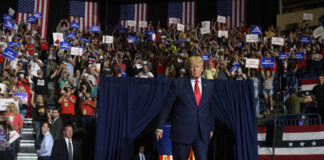JULY 26, 2022

In recent months, the various investigations into Jan. 6 have increasingly zeroed in on the “fake” electors for President Donald Trump. In states that Trump lost, the fake electors were people who claimed they were duly chosen — something he later tried to leverage to get Vice President Mike Pence to help overturn the election on that fateful day.
But both when they were designated on Dec. 14, 2020, and since, these fake electors have almost always been described as a contingency plan. Dec. 14 was the elector deadline, and the idea was supposedly that they needed to be in place just in case the election results were changed before Jan. 6. Perhaps Trump and Co. later “misuse[d]” the fake electors to try to overturn the election regardless, as Georgia’s fake electors suggested last week in court, but the fake electors themselves shouldn’t be held responsible for that if they had no knowledge of that plan.
New evidence, though, suggests that at least some involved might have understood the fake-elector plan differently — from very early in the process.
A New York Times report details a batch of new emails related to the fake-elector plot. Figuring prominently is a Phoenix-based lawyer who worked with the Trump campaign, Jack Wilenchik.
Wilenchik corresponded with Trump campaign adviser Boris Epshteyn and others on Dec. 8, according to the Times report. In one email, he outright refers to the electors as “ ‘fake’ electors,” before later suggesting that a more palatable phrase would be “alternate” electors.
Many have suggested that this line shows that those involved knew these electors were “fake” to begin with. However, Wilenchik used the word in quotation marks, perhaps suggesting he was borrowing someone else’s word.
But perhaps the more striking development is how he described their purpose.
“We would just be sending in ‘fake’ electoral votes to Pence so that ‘someone’ in Congress can make an objection when they start counting votes, and start arguing that the ‘fake’ votes should be counted,” Wilenchik wrote to Epshteyn. He summarized a proposal by Trump-allied lawyer Kenneth Chesebro as designating the fake electors “so that members of Congress can fight about whether they should be counted on January 6th.”
Chesebro, in a Nov. 18 memo, had indeed pushed for the fake electors. But he described them as necessary in case of “a court decision (or, perhaps, a state legislative determination) rendered after December 14 in favor of the Trump-Pence slate of electors.” Wilenchik seemed to be skipping over that and suggesting that the fake electors’ mere existence might be enough to throw things into doubt on Jan. 6.
It’s possible Wilenchik, too, viewed that fight as taking place after certain court decisions or state legislative actions. But elsewhere he suggested at least one key figure involved had more secretive ideas: Arizona Republican Party Chairwoman Kelli Ward.
Wilenchik said in another Dec. 8 email that Ward wanted “to keep it under wraps until Congress counts the vote Jan. 6th (so we can try to ‘surprise’ the Dems and media with it) — I tend to agree with her.” (Ward was subpoenaed last month as part of the federal probe into the fake-elector plot.)
The idea was apparently that the slate of fake electors would somehow be kept secret before Jan. 6 and then be sprung on an unsuspecting political world when Congress counted the electoral votes. Precisely why isn’t clear, but it’s certainly a remarkable plot to overturn democracy.
It’s also very difficult to square with the fake-elector plot being characterized as merely a contingency.
When Trump lawyer Rudy Giuliani publicly acknowledged his role with the fake electors on Dec. 14, he pitched it as a contingency in case the campaign’s election challenges succeeded.
In her testimony to the Jan. 6 committee, Republican National Committee Chairwoman Ronna McDaniel confirmed Trump’s own personal involvement with the fake-electors plan. She also said another Trump lawyer, John Eastman, espoused (in her words) “the importance of the RNC helping the campaign gather these contingent electors in case any of the legal challenges that were ongoing changed the result of any of the states.”
And just last week, the Georgia fake electors who have been targeted by a local prosecutor for potentially breaking the law cited their understanding that they were contingent electors and nothing more.
“[T]he nominee electors did not and could not have had any involvement in or knowledge of any such plan, as it was not even conceived until several weeks after the GOP electors had completed their contingent electoral slates on December 14, 2020,” their attorneys wrote. “And, in any event, it was never disclosed to or discussed with the nominee electors at any time.”
There’s some real nuance here, and perhaps many involved genuinely believed this was a contingency. But keeping the process secret through Jan. 6 would seem unnecessary if that was the true goal.
Wilenchik and a spokeswoman for Ward didn’t immediately respond to a request for comment.
This isn’t the first evidence that at least some involved expressed a desire for secrecy for the fake electors. The Washington Post reported last month that, in one Dec. 13 email, a Trump campaign staffer in Georgia pushed for “complete secrecy and discretion” as the fake electors met the following day. But Georgia Republican Party Chairman David Shafer (a fake elector himself) emphasized that he publicized the event that day.
A valid question in all of this is just how many people might have understood the fake electors as not just a contingency but also a potential Hail Mary for Jan. 6 — deployable regardless of court or state legislative action, which is how Trump and Co. ultimately sought to use them when no courts or state legislatures complied. If others viewed them accordingly, it would certainly increase the evidence of corrupt intent, given the plot to have Pence reject the legitimate electors might well have been illegal, and this would suggest at least some people sought to obscure their plans.
Adding to the intrigue are past comments from a Trump elector in Pennsylvania, Sam DeMarco. He told CNN in January that there was an 11th-hour dispute between the electors and the Trump campaign over whether the document would state the contingency explicitly. (Such language about contingency was ultimately included in New Mexico and Pennsylvania, but not in five other states).
DeMarco said the Trump campaign wanted no contingency, but the fake electors insisted upon it:
Demarco, who was one of the state’s pro-Trump electors, and is the chairman of the Allegheny County Republican Committee, told CNN that he and other alternate electors signed the certificate at the Trump campaign’s request but first demanded the language be changed to make clear it was not intended to contest the will of voters in that state who voted for [Joe] Biden.
Demarco, who was one of the state’s pro-Trump electors, and is the chairman of the Allegheny County Republican Committee, told CNN that he and other alternate electors signed the certificate at the Trump campaign’s request but first demanded the language be changed to make clear it was not intended to contest the will of voters in that state who voted for [Joe] Biden.
The hedging language was included at the last moment as the Trump campaign had concerns, and questioned whether the change was appropriate in the immediate lead-up to December 14, according to a Trump campaign staffer with knowledge of the matter.
The hedging language was included at the last moment as the Trump campaign had concerns, and questioned whether the change was appropriate in the immediate lead-up to December 14, according to a Trump campaign staffer with knowledge of the matter.
Ultimately the Trump campaign acquiesced. But the internal debate shows that even some of Trump’s strongest allies were concerned about the attempts to overturn the 2020 election.
Ultimately the Trump campaign acquiesced. But the internal debate shows that even some of Trump’s strongest allies were concerned about the attempts to overturn the 2020 election.
The final language included the caveat: “on the understanding that if, as a result of a final non-appealable Court Order or other proceeding prescribed by law, we are ultimately recognized as being the duly elected and qualified Electors.”
Why object to that contingency being made explicit? And how much was this truly just a contingency? It seems we’re likely to find out quite a bit more about that.







































































































